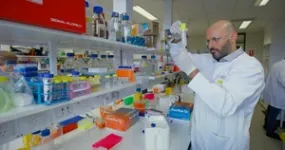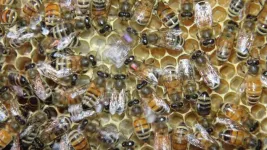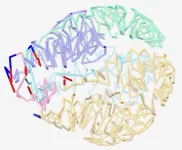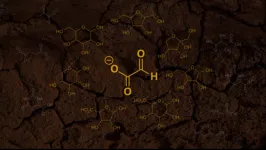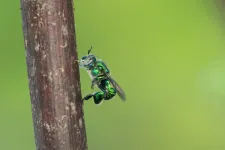(Press-News.org) Three-dimensional simulations shed light on how energy dissipates within non-Newtonian fluids (fluids in which viscosity depend on the shear rate.) The result is valuable in the context of disaster forecast and management or industrial production.
Elastoviscoplastic (EVP) fluids like mud, concrete, and lava are a type of non-Newtonian fluid that exhibit both solid and fluid-like behavior depending on the forces they are subjected to (i.e., applied stress). Their flow behavior is more complex than that of Newtonian fluids, such as water and air, which have a constant viscosity. In a recent study, researchers performed simulations of turbulent EVP fluids, revealing novel insights on the energy transfer mechanism across different scales.
Water, air, oil, and alcohol are well-known examples of fluids. However, they only constitute a particular subset of the possible types of fluids, namely the subset of Newtonian fluids. As the name suggests, Newtonian fluids are those that obey Newton’s law of viscosity, characterized by a linear relation between the shear stress and the shear rate. Another way to put it is that the viscosity of Newtonian fluids is independent of the shear rate.
In contrast, non-Newtonian fluids do not follow this classical definition, meaning their viscosity changes depending on the forces they are subjected to. For example, elastoviscoplastic (EVP) fluids are a type of non-Newtonian fluid that behave either like a solid or fluid depending on the applied stress. At low stress, they tend to preserve their shape and resist deformation. In contrast, at high stress, they flow like liquids. While EVP fluids are less common than Newtonian fluids in our daily lives, some familiar examples include mud, concrete, and toothpaste.
It turns out that understanding how EVP fluids behave during turbulent flow is important in many industrial settings where viscosity can greatly affect the efficiency of a process. Although turbulence is inherently unpredictable and chaotic, characterizing fluid flow behavior at very high flow speeds, some aspects of it can be modeled and described. In particular, a theory put forward by Andrey N. Kolmogorov in 1941 describes how energy is transferred from large to small scales in turbulent Newtonian fluids, prescribing a power-law scaling for the fluid’s energy spectrum. However, not much is known about the turbulent behavior of EVP fluids, including whether the Kolmogorov’s scaling law holds for them.
Against this backdrop, a research team from the Complex Fluids and Flows Unit at Okinawa Institute of Science and Technology (OIST) in Japan decided to analyze the problem in detail. The team, consisting of two PhD students, Mr. Mohamed Abdelgawad and Mr. Ianto Cannon, and Professor Marco Edoardo Rosti, ran 3D numerical simulations of EVP fluids showing a homogeneous, isotropic turbulence and focused on their plastic behavior. Their findings were published in the journal Nature Physics.
One of the most important results of the study was related to the energy distribution within a turbulent EVP fluid. In turbulent flows, energy is transferred from large to small scales through a cascade of vortices and eddies. This distribution of energy across scales can be quantified using an energy spectrum. “For Newtonian fluids like water, the energy spectrum follows Kolmogorov’s scaling with a scaling exponent of −5/3. This scaling is well-established and has been confirmed in many experiments and simulations,” explains Mr. Abdelgawad. “In our study, however, we found that plastic effects in EVP fluids alter their turbulent behavior, giving rise to a new scaling exponent of −2.3. This suggests a different energy transfer mechanism, unlike our classical understanding of turbulence in Newtonian fluids.”
Excited, the researchers sought to unveil this new mechanism. Through further analysis of the simulation data, they showed that EVP fluids do not, in fact, obey Kolmogorov’s theory and, instead, show an energy dissipation pattern that resembles a fractal (a non-regular geometric shape with non-regularity at all scales). More specifically, the energy dissipation in turbulent EVP fluids is multifractal, meaning the degree of non-regularity changes with scale.
Further, the team observed that another key difference between turbulent Newtonian fluids and EVP fluids was in their “intermittency,” with EVP fluids showing a relatively higher intermittency, a property that characterizes the likelihood of extreme events occurring, such as localized regions of high flow velocity or high energy dissipation. Given that natural disasters like landslides and volcanic eruptions involve turbulent EVP fluids, this result is particularly valuable in the context of disaster forecast and management.
Additionally, the findings of this work can be leveraged to design and optimize a wide range of industrial process, including polymer manufacture, concrete pumping, mud drilling, and oil production. “Our work will contribute to a more comprehensive understanding of the behavior of turbulent non-Newtonian fluids in general, which could help us model the flow of high plasticity fluids better. In addition, it can have far-reaching implications for a range of industries, including pharmaceuticals, food processing, and energy,” concludes Mr. Cannon.
Let us hope further insights about these fluids keep flowing in!
END
Towards a deeper understanding of turbulence in elastoviscoplastic fluids
Three-dimensional simulations shed light on how energy dissipates within non-Newtonian fluids.
2023-04-13
ELSE PRESS RELEASES FROM THIS DATE:
Stop signals reduce dopamine levels and dancing in honeybees
2023-04-13
Researchers from the Xishuangbanna Tropical Botanical Garden (XTBG) of the Chinese Academy of Sciences and the University of California San Diego have revealed that receiving an inhibitory signal (stop signal) associated with negative food conditions can decrease brain dopamine levels in dancing honeybees.
The study was published in Current Biology on April 13.
Dopamine is known as the feel-good neurotransmitter—a chemical that ferries information between neurons. In multiple animals, dopamine is involved in arousal, cognition, and sensitivity to stimuli. It is also associated with seeking and wanting behavior, particularly ...
Health care–associated infections among hospitalized patients with vs without COVID-19
2023-04-13
About The Study: In this analysis of more than 5 million hospitalizations between 2020 and 2022, health care–associated infection (HAI) occurrence among inpatients without COVID-19 was similar to that during 2019 despite additional pressures for infection control and health care professionals. The findings suggest that patients with COVID-19 may be more susceptible to HAIs and may require additional prevention measures.
Authors: Kenneth E. Sands, M.D., M.P.H., of HCA Healthcare in Nashville, is the corresponding author.
To access the embargoed study: Visit our For The Media website at this link https://media.jamanetwork.com/
(doi:10.1001/jamanetworkopen.2023.8059)
Editor’s ...
Risk of new retinal vascular occlusion after mRNA COVID-19 vaccination
2023-04-13
About The Study: The findings of this study including more than 3 million patients receiving the mRNA COVID-19 vaccine suggest that retinal vascular occlusion (RVO) diagnosed acutely after vaccination occurs extremely rarely at rates similar to those of two different historically used vaccinations, the influenza and tetanus, diphtheria, pertussis (Tdap) vaccines. No evidence suggesting an association between the mRNA COVID-19 vaccination and newly diagnosed RVO was found.
Authors: Rishi P. Singh, M.D., of ...
[EMBARGOED] The 2020 election saw fewer people clicking on misinformation websites, Stanford study finds
2023-04-13
In the run-up to the 2020 election, people appear to have become savvier in spotting misinformation online: clicks onto unreliable websites have declined, according to a new Stanford study published April 13 in the journal Nature Human Behaviour. According to prior research, some 44.3 percent of Americans visited websites during the 2016 U.S. election that repeatedly made false or misleading information.
During the 2020 election, Stanford scholars saw that number drop by nearly half to 26.2 percent.
While these findings ...
Curtin researchers map genetic signature of precursor to liver cancer
2023-04-13
Researchers at Curtin University have identified the genetic signature of pre-malignant liver cells, offering potentially significant implications for the almost 3,000 Australians diagnosed with the deadly cancer each year.
The study, published in the prestigious journal Cell Genomics, found that quantifying pre-malignant liver cells in patients with liver disease could help determine their future risk of developing liver cancer.
First author Dr Rodrigo Carlessi, from the Curtin Medical School and the Curtin Health Innovation Research Institute, said the discovery had the potential to save lives by changing how chronic liver disease patients ...
One brain, multiple and simultaneous alternative decision strategies
2023-04-13
Choosing a checkout line in a supermarket might seem like a no-brainer, but it can actually involve a complex series of cerebral computations. Maybe you count the number of shoppers in each line and pick the shortest, or estimate the number of items on each conveyor belt. Perhaps you quickly weigh up both shoppers and items and maybe even the apparent speed of the cashier... In fact, there are a multiplicity of strategies for solving this problem.
So how does the brain know how to make decisions ...
Researchers warn of tick-borne disease babesiosis
2023-04-13
RIVERSIDE, Calif. -- 'Tis the season for hiking now that spring has arrived and temperatures are on the upswing. But with hikes come insect bites and on the increase in North America is babesiosis, a malaria-like disease spread especially between May and October by a tick.
Indeed, recent research suggests an increase in the incidence of diseases transmitted by ticks around the world, not just the United States and Canada, due likely to climate change and other environmental factors. Among the tick-borne pathogens, Babesia parasites, which infect and destroy red blood cells, are considered a serious ...
Where did the first sugars come from?
2023-04-13
LA JOLLA, CA— Two prominent origin-of-life chemists have published a new hypothesis for how the first sugars—which were necessary for life to evolve—arose on the early Earth.
In a paper that appeared on April 13, 2023, in the journal Chem, the chemists from Scripps Research and the Georgia Institute of Technology propose that key sugars needed for making early life forms could have emerged from reactions involving glyoxylate (C2HO3–), a relatively simple chemical that plausibly existed on the Earth before life evolved.
“We show that our new hypothesis has key advantages over the more traditional view ...
Conservation: Red-throated loons avoid North Sea windfarms
2023-04-13
Offshore wind farms in the North Sea reduce the population of loons –fish-eating aquatic birds also known as divers – by 94% within a one-kilometre zone, according to new research published in Scientific Reports. The findings highlight the need to minimise the impact of offshore wind farms on seabirds, while balancing this effort with the demand for renewable energy.
Previous research has found that different seabird species respond to offshore windfarms differently – they may avoid the area which can lead to habitat displacement or they may be attracted to the area which can increase mortality via collisions with the turbines. However, it is difficult ...
Why orchid bees concoct their own fragrance
2023-04-13
Male bees display a remarkable passion for collecting scents: they deposit scents from various sources in special pockets on their hind legs, thus composing their own fragrance. This behaviour has been known since the 1960s. The reason why they do it has been the subject of much speculation just as long. Researchers from Ruhr University Bochum, Germany, in collaboration with colleagues from the University of California at Davis and the University of Florida at Fort Lauderdale, have finally solved the mystery. The bee fragrance serves as a sex attractant and increases the reproductive success of the males, as the team found out after three years ...
LAST 30 PRESS RELEASES:
Post-stroke injection protects the brain in preclinical study
Cardiovascular risk score predicts multiple eye diseases
Health: estimated one in ten British adults used or interested in GLP-1 medications for weight loss
Exercise to treat depression yields similar results to therapy
Whooping cough vaccination for pregnant women strengthens babies’ immune system
Dramatic decline in new cases of orphanhood in Uganda driven by HIV treatment and prevention programs
Stopping weight loss drugs linked to weight regain and reversal of heart health markers
Higher intake of food preservatives linked to increased cancer risk
Mass General Brigham–developed cholera vaccine completes phase 1 trial
First experimental validation of a “150-year-old chemical common sense” direct visualization of the molecular structural changes in the ultrafast anthracene [4+4] photocycloaddition reaction
Lack of support for people on weight loss drugs leaves them vulnerable to nutritional deficiencies, say experts
Dogs’ dinners can have greater climate impact than owners’
Are you ready to swap salmon for sprats and sardines?
1.6 million UK adults used weight loss drugs in past year
American College of Cardiology comments on new dietary guidelines for Americans
American Society of Gene & Cell Therapy and Orphan Therapeutics Accelerator partner to advance and commercialize promising rare disease treatments
One in 14 patients having day case surgery have new or worse chronic pain 3 months after their operation
New study highlights link between eviction rates and gun violence
Heatwaves heat up soil but not toxin levels in rice, study finds
Digital modeling reveals where construction carbon emissions really come from
Turning farm waste into water filters
New study shows how the spleen helps the immune system accept a transplant
New Mayo Clinic study advances personalized prostate cancer education with an EHR-integrated AI agent
Researchers identify novel therapeutic target to improve recovery after nerve injury
Microbes in breast milk help populate infant gut microbiomes
Reprogramming immunity to rewrite the story of Type 1 diabetes
New tool narrows the search for ideal material structures
Artificial saliva containing sugarcane protein helps protect the teeth of patients with head and neck cancer
Understanding the role of linear ubiquitination in T-tubule biogenesis
Researchers identify urban atmosphere as primary reservoir of microplastics
[Press-News.org] Towards a deeper understanding of turbulence in elastoviscoplastic fluidsThree-dimensional simulations shed light on how energy dissipates within non-Newtonian fluids.


